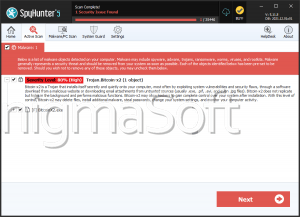Bitcoin-x2 Ransomware
The Bitcoin-x2 Ransomware is an encryption ransomware Trojan that is being distributed through a tactic that involves a program named 'Bitcoin Multiplier.' Bitcoin, an online currency, has risen in value in 2017 dramatically. This valorization has attracted widespread attention to this online currency and being of high interest to computer users that are looking for an easy version to make money-using Bitcoin. The Bitcoin-x2 Ransomware is being distributed as a fake program that supposedly allows computer users to multiply the Bitcoins in their Bitcoin wallets, a clear tactic for anyone that understands how Bitcoin works. According to this fake program's developers, they claim that they can exploit vulnerabilities in the blockchain to multiply the computer user's Bitcoins. Instead, the Bitcoin-x2 Ransomware is installed on the victim's computer. Once installed, the Bitcoin-x2 Ransomware will be used to encrypt the victims' data to extort the victim.
Table of Contents
The Bitcoin-x2 Ransomware Infection Tries to Trick PC Users into Installing It
Once the victim tries to install the Bitcoin Multiplier, the Bitcoin-x2 Ransomware will be installed. While the Bitcoin-x2 Ransomware Trojan is being installed, a program window named 'Bitcoin-x2 v5.1' will be displayed, probably to occupy the victim while the threat is being installed. This is a diversion meant to trick the computer user into installing the Bitcoin-x2 Ransomware and not acting while their data is being encrypted by the attack. Once the Bitcoin-x2 Ransomware is installed, it uses a strong encryption algorithm to make the victim's files inaccessible, essentially taking the victim's data hostage. Threats like the Bitcoin-x2 Ransomware will use a combination of the AES and RSA encryptions to encrypt the victim's files. Some of the file types that may be encrypted by threats like the Bitcoin-x2 Ransomware are:
.3dm, .3g2, .3gp, .7zip, .aaf, .accdb, .aep, .aepx, .aet, .ai, .aif, .as, .as3, .asf, .asp, .asx, .avi, .bmp, .c, .class, .cpp, .cs, .csv, .dat, .db, .dbf, .doc, .docb, .docm, .docx, .dot, .dotm, .dotx, .dwg, .dxf, .efx, .eps, .fla, .flv, .gif, .h, .idml, .iff, .indb, .indd, .indl, .indt, .inx, .jar, .java, .jpeg, .jpg, .js, .m3u, .m3u8, .m4u, .max, .mdb, .mid, .mkv, .mov, .mp3, .mp4, .mpa, .mpeg, .mpg, .msg, .pdb, .pdf, .php, .plb, .pmd, .png, .pot, .potm, .potx, .ppam, .ppj, .pps, .ppsm, .ppsx, .ppt, .pptm, .pptx, .prel, .prproj, .ps, .psd, .py, .ra, .rar, .raw, .rb, .rtf, .sdf, .sdf, .ses, .sldm, .sldx, .sql, .svg, .swf, .tif, .txt, .vcf, .vob, .wav, .wma, .wmv, .wpd, .wps, .xla, .xlam, .xll, .xlm, .xls, .xlsb, .xlsm, .xlsx, .xlt, .xltm, .xltx, .xlw, .xml, .xqx, .xqx, .zip.
The Bitcoin-x2 Ransomware’s Ransom Note
The Bitcoin-x2 Ransomware runs on the victim's computer as a file named 'BitcoinX2.exe.' The Bitcoin-x2 Ransomware delivers its ransom note in the form of a text file named 'How_to_Decrypt_files.txt' that is dropped onto the victim's computer's desktop. The Bitcoin-x2 Ransomware's ransom note demands a ransom payment that is typically between 200 and 300 USD. Once the Bitcoin-x2 Ransomware attack encrypts a file, it will not be recognizable by the Windows Explorer and will show up as a blank icon. Victims of the attack are asked to contact the cybercrooks at the email address 'mommud@mail2tor.com' to receive information about how to pay the ransom amount.
Dealing with the Bitcoin-x2 Ransomware Attack
Computer users are advised to take steps to protect their data from attacks like the Bitcoin-x2 Ransomware. The best protection against these infections is to use an effective backup method, to have backup copies of their files on an external memory device or the cloud. Having file backups means that computer users can restore their files from the backup instead of having to negotiate with cybercrooks or losing the files permanently. The Bitcoin-x2 Ransomware itself should be removed by the affected computer user with a skilled anti-malware tool. It is important to educate oneself about Bitcoins and other potential investments and to avoid software that offers ways to cheat such as this supposed Bitcoin Multiplier. Almost invariably, these programs are hoaxes designed to take advantage of inexperienced computer users.


